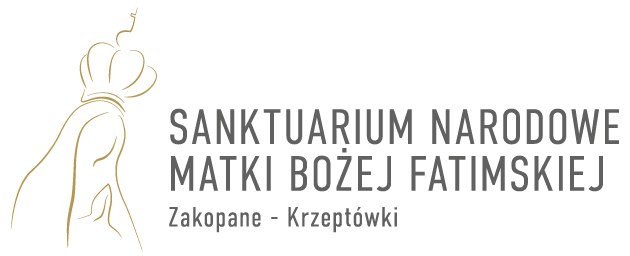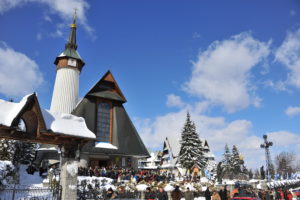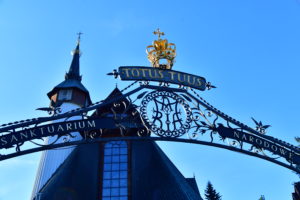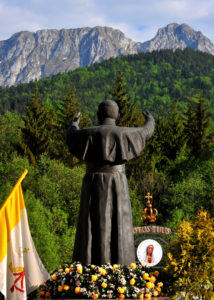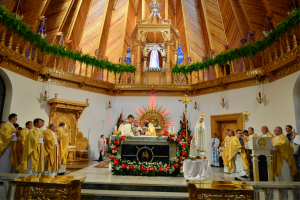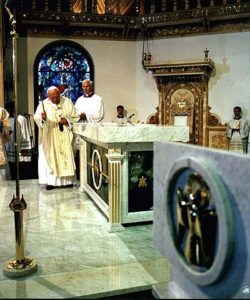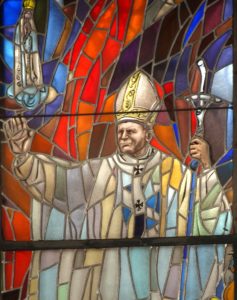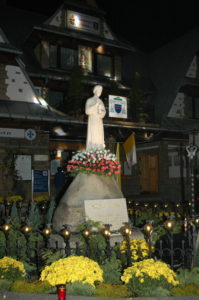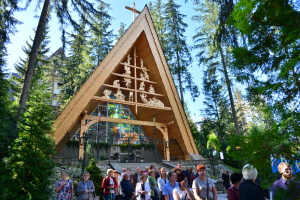The Shrine is a sacred place. It is a sign of God’s presence among people. The Shrine speaks to the pilgrims through a variety of symbols, which allow them to experience the warmth and protection of the maternal Heart of Mary and open up to the divine activity. These sacred symbols accompany pilgrims at every step throughout the Shrine. The most important of them are discussed below.
CROSS AT THE PARISH BORDER
On the border of the parish, the pilgrims are welcomed by the Crucified Christ, leading them to the home of his Mother. From the height of the Cross, the Saviour gave us Mary for Mother. Every person standing below it, should hear the words uttered to John by dying Christ: “Here is your mother.” And just like the beloved disciple of Christ, about whom we read in the Gospel, we should take Mary into our homes. That is precisely why we visit the Shrine: to meet Mary there and take her home with us, into our daily lives.
The road to the Shrine is marked by special signs hanging over the street. They serve as the last stage of preparation for the pilgrims before the meeting with Our Lady of Fatima and her Son. They remind us of the need to entrust ourselves to the Holy Mother, and also of the importance of the rosary prayer. Quotes from the teachings of Pope John Paul II constitute further help in the contemplation. Additionally, decades of the rosary have been incorporated into the fence, so that the Shrine’s area would become symbolically entwined with the prayer, which was requested by Our Lady of Fatima.
ROSARY WALL ENTWINING THE SHRINE
One of the most important messages of Our Lady of Fatima is her continuous request to pray the rosary every day. Hence, the Shrine itself is encircled with the rosary, revealing its role as the centre of this prayer. In Fatima, John Paul II said the words that also define our way of pilgrimage: “I have come on pilgrimage to Fatima, like most of you, Dear Pilgrims, with the rosary beads in my hand, the name of Mary on my lips and the song of the mercy of God in my heart. (…) You want me to entrust you with the «Secret»? (…) It’s simple and it’s no longer a secret: «Pray, pray a lot, pray the rosary every day!»”.
GATE OF ENTRUSTMENT
Pilgrims enter the Shrine through a gate crowned with a Marian crown and the inscription “Totus Tuus”. It reminds us of how John Paul II placed his trust in the Holy Mother – showing the attitude for which Mary had asked during her apparitions in Fatima. In 1982, while on his first pilgrimage to Fatima, the Holy Father said: “You certainly know that I have cultivated the Christian practice of pilgrimage ever since my youth (…). At this hour, here at the Shrine of Fatima, I wish to repeat now, before you all: totus tuus – all yours, O Mother! (…) for you, O Mother: «do whatever He [Christ] tells us to»”. In Zakopane he pronounced: “Here, together with you, I wish once more to thank Our Lady of Fatima for the gift of my life having been spared, as I did at Fatima fifteen years ago. Totus tuus…”.
Shouldn’t we be encouraged to repeat these words of the Pilgrim Pope, when crossing the threshold of the Fatima Shrine? Indeed, the Gate of Entrustment invites everyone who passes through it to make the declaration “All yours, Mary” deep in his heart. Thus, we could enter the Shrine as a person fully devoted to the Holy Mother.
THE HOLY FATHER AND MOUNT GIEWONT CROSS
At the entrance to the temple stands a statue of John Paul II. The pope looks at the scenery of the Tatra Mountains and stretches his hands in the direction of the cross on Mount Giewont, about which he spoke so beautifully on the eve of his visit to the Shrine: “your forebears planted a Cross on the top of Giewont. It is there and remains there still. The Cross is a silent but eloquent witness to our time. It can be said that this Jubilee Cross looks in the direction of Zakopane and Krakow, and beyond: in the direction of Warsaw and Gdańsk. It embraces all our land from the Tatra to the Baltic. (…) Dear Brothers and Sisters, do not be ashamed of this Cross. Try every day to accept it and to return Christ’s love. Defend the Cross…”.
Above the entrance the following inscription can be read: “Shrine of Our Lady of Fatima, votive offering for saving the Holy Father on May 13, 1981″. It serves as a reminder of the original intention which accompanied the people who built the temple, and which still accompanies those who pray inside. At the entrance there are two marble plaques. The first is related to the crowning of the statue, which was pilgrimaging throughout Poland for twenty-six years. The second bears the words that John Paul II directed at his countrymen on October 22, 1978: “Please, be with me. Pray for me.” This plaque gives first impressions of the pastoral work carried out by the Shrine. The words of the Holy Father have been adopted here as a “papal testament”, as an obligation to be fulfilled each and every day. The plaques placed on the front wall introduce the pilgrims into the spiritual ambience of the Shrine.
RELICS
The relics are located in the vestibule of the church. On the left, the relics of Crucis D.N.J.C., the Cross of our Lord Jesus Christ, were placed. It has a deep symbolic meaning, since, as John Paul II explained in his homily, “The Immaculate Heart of Mary, (…) was opened to us on Calvary by the words of the dying Jesus: «Woman, behold your son! (…) Behold, your mother!»”. These priceless relics remind us of yet another part of the teachings of the Holy Father: “true devotion to the Mother of God is actually Christocentric, indeed, it is very profoundly rooted in the Mystery of the Blessed Trinity and the Mysteries of the Incarnation and Redemption” (from Crossing the Threshold of Hope).
On the right, there are the relics of the great Marian saint, Louis Grignion de Montfort, whom John Paul II considered his spiritual guide. It is worth reminding that the Holy Father drew the formula totus tuus, which inspired his entire pontificate, from the writings of St. Louis. The Pope explained that his devotion to the Mother of God developed amidst the hard times of war: “When I was working as a clandestine seminarian at the Solvay factory in Kraków, my spiritual director advised me to meditate on the «True Devotion to the Blessed Virgin». Many times and with great spiritual profit I read and reread this precious little ascetical book with the blue, soda-stained cover. By relating the Mother of Christ to the Trinitarian mystery, Montfort helped me to understand that the Virgin belongs to the plan of salvation (…). Mary’s every intervention in the work of the regeneration of the faithful is not in competition with Christ, but derives from him and is at his service. Mary’s action in the plan of salvation is always Christocentric, that is, it is directly related to a mediation that takes place in Christ.” St. Louis, unnoticed by the pilgrims, keeps the honorary guard at the temple’s gate and fills its interior with his spirituality.These are not the only relics that can be found in the Shrine. Others are located on both sides of the church, marking the exact places where the Holy Father had anointed the temple with chrism during the consecration rites, on June 7, 1997. The guardian saints of the temple encircle the praying pilgrims in a kind of solemn line, symbolically protecting the church by day and by night.
THEOLOGY OF THE TEMPLE
Above the door leading to the crypt of the church, there is a Latin inscription:
MONSTRA TE ESSE MATREM
– “Show yourself the Mother”
These exact words were repeated in the Act of Entrustment to Our Lady of Fatima, pronounced by John Paul II in Fatima on the 10th anniversary of the assassination attempt. The Pope prayed: “Yes, continue to show yourself the Mother to all, because the world is in need of You… Show yourself the Mother of the poor people… Show yourself the Mother of unity and peace… Show yourself the Mother of hope!”. The words of this prayer have the power to reach the Holy Mother, Our Lady of Fatima, who protects the Shrine and the praying pilgrims.
Hence, the entrance gate of the Shrine reminds the pilgrims of the papal entrustment and consecration to the Virgin of Fatima. Once inside, their eyes are immediately drawn towards the presbytery, where the Mother of God watches over her Son, present in the Eucharist.
When the Holy Father celebrated the Mass in this temple, “looking at the church, so beautifully decorated”, he understood it as an epitome of the new churches in Podhale region. According to the Pope, “their beauty matches the beauty of the Tatra Mountains and is the reflection of the same beauty spoken of in the inscription on the Cross by Wincenty Pol in Kościeliska Valley: «Nothing is greater than God»”.
PRESBYTERY
The presbytery is the essential space of every temple, since it is a place devoted to celebrating the redemptive sacrifice of Christ. The Eucharist constitutes the beating heart of every Shrine. Thus, the place in which it is stored is of crucial importance. So is the altar, where the Eucharist is exposed for adoration and incarnated as the Holy Communion. In his homily, John Paul II spoke the following about churches: “They were built by a common effort, so that the Holy Sacrifice could be celebrated there, so that Christ in the Eucharist would be together with his people day and night, at times of great joy and elation, and at times of trial, suffering and humiliation, and even on plain grey days”.
The presbytery of the Shrine Our Lady of Fatima was given the shape of a papal tiara, so that it would visibly remind the faithful of the main intention of the prayers originally offered here. Moreover, the presbytery itself reveals the truth about the primary role of the Eucharist and the complementary role of the Virgin Mary. Namely, the Holy Mother is watching over Her Son, hidden in the Blessed Sacrament. The tabernacle is shaped as a monstrance. This symbol communicates one of the essential truths disclosed in the Fatima apparitions: it illustrates the living and real presence of Jesus in the Eucharist, and the obligation to adore the Blessed Sacrament.
Above the tabernacle, the statue of Our Lady of Fatima was placed. The Holy Mother is surrounded by rays of light, just as she always was when she appeared to the children of Fatima. Thus, we could say that the Virgin Mary is keeping guard over Christ, conveyed in the Blessed Sacrament. The statue was brought to the Shrine directly from Fatima. It depicts the Holy Mother of the June apparition – when she exposed her Immaculate Heart to the three Shepherds.
PAPAL THRONE
In order to celebrate the arrival of John Paul II in June 1997, a special throne was made for him. The Holy Father preached a homily sitting on this throne. Today it remains part of the decor of the temple, serving as a sign of the spiritual presence of the Holy Father. It directs the attention of the pilgrims to the papal teachings, especially the one preached here in Zakopane during the consecration of the Shrine.
VOTIVE OFFERINGS
“Numerous votive offerings are made in the Shrine. They are placed here a sign of thanksgiving for the miraculously saved life of the Holy Father. These votive offerings have a special meaning. ” (from the interview with the Father Curator)
Votive offerings for the received favours are also documented in the “Golden Book”, where the pilgrims themselves can express their gratitude. We read, for instance: “We were here and we prayed for the Holy Father John Paul II, Bożena and Gabriel Turowscy (July 1992); “We thank you for saving the life of the Holy Father John Paul II, and ask you for further protection over him, Mariola and Mirosław Pałaszewscy (July 1992)”; “Thank you, Mother of God, the Lady of Fatima, for saving the Holy Father. Pilgrims from Kamiów (February 1993).
STAINED-GLASS WINDOWS
The light which illuminates the interior of the temple passes through numerous stained-glass windows. Albeit their silence, these images tell the story of the Fatima message.
– Apparition of the Angel in 1916, during which he instilled the children with the Eucharistic worship
– Pope Pius XII performs the first Consecration of the World to the Immaculate Heart of Mary in 1942; in his speech the pope refers to Fatima as “the hope of the world”
– Pope John Paul II
– Pope Paul VI pilgrimages to Fatima in 1967
– The assassination attempt on Pope John Paul II in 1981; the bullets miraculously bypass the vital organs of the Pope
– Virgin Mary appears in Fatima for the first time, on May 13, 1917
– Cardinal Wyszyński entrusts the statue of Our Lady of Fatima to the Pallottine Fathers, 1961
– Pope John Paul II crowns the Marian statue from Zakopane at St. Peter’s Square and thanks Mary for her vital role in the evangelization of Poland, in 1987
WAY OF THE CROSS
Two of the Stations of the Cross, placed on the walls of the temple, contain papal motifs. The intention behind this is to make the pilgrims realize the role played by Pope John Paul II in the continuing history of salvation. These stations point to the union, which the Holy Father has established with Christ by partaking in his suffering. At the fifth station, John Paul II helps Jesus to carry the cross, symbolically taking the place of Simon of Cyrene. At the twelfth station, the Holy Father – instead of John the Apostle – accompanies Mary under the Cross of the dying Christ.
Many more details of the interior remind the pilgrims of the Holy Father John Paul II. Among those worth paying special attention are: the papal coat of arms, placed over the presbytery arch, the door leading to the sacristy and the Totus tuusinscription above the choir.
THE ANGEL OF PEACE
The apparitions of Our Lady in Fatima were preceded by three apparitions of the Angel of Peace, who had prepared the children for the meeting with the Holy Mother. The statue, placed in front of the entrance to the chapel, represents the scene of the last apparition of the Angel (in 1916).
In her memoires, Sister Lucia thus describes the third apparition of the Angel: “…an extraordinary light shone upon us. We sprang up to see what was happening, and beheld the Angel. He was holding a chalice in his left hand, with the Host suspended above it, from which some drops of blood fell into the chalice. Leaving the chalice suspended in the air, the Angel knelt down beside us and made us repeat three times: «Most Holy Trinity, Father, Son and Holy Spirit, I adore You profoundly, and I offer You the most precious Body, Blood, Soul and Divinity of Jesus Christ, present in all the tabernacles of the world, in reparation for the outrages, sacrileges and indifference with which He Himself is offended. And, through the infinite merits of His most Sacred Heart, and the Immaculate Heart of Mary, I beg of You the conversion of poor sinners»”.
The statue of the Angel is supposed to prepare the pilgrims for the meeting with Our Lady, which awaits them at the Chapel of the Immaculate Heart of Mary. Entwined with a rosary-like fence, the sculpture reminds of the substantial elements of the message of Fatima: the importance of the rosary prayer and the crucial role of the Eucharist. The statue was brought directly from Fatima and is an exact copy of the original figure, which marks the place of the preparatory apparitions of the Angel of Peace to Lucia, Francisco and Jacinta.
In fact, the statue stands on a stone brought from the place of the Angel’s apparitions. The stone had been cut in half, so that one part could be offered to the Shrine in Zakopane, while the other has remained in Fatima. The stone in Krzeptówki is a fragment of the rock on which the Angel of Peace knelt, while adoring the Blessed Sacrament with the children. The Shrine of Our Lady of Fatima in Zakopane is the only place in the world that possesses such a precious relic.
STATUE OF OUR LADY OF FATIMA
The Chapel of the Immaculate Heart of Mary, also known as the “old chapel”, is where Our Lady of Fatima has been continuously honoured since 1950. Moreover, it was the centre of the intense prayer for spearing the Pope’s life from the day of the deadly attempt. The Holy Father referred to this fact when he was consecrating the Shrine: “In it you honour the statue of Our Lady of Fatima. (…) I know that you gathered in your parish churches and in the Chapel of Our Lady of Fatima in Krzeptówki to recite the rosary to obtain for me a recovery of health and strength. (…) It is hard for me to speak of this without being moved.”
The chapel houses a miraculous statue of Our Lady of Fatima. In 1961, the Bishop of Leiria conferred it to Cardinal Wyszyński, who passed it to the Pallottines. The statue was blessed by the then Bishop Wojtyła, and soon it set out on a twenty year long pilgrimage around Poland, bringing people a message of hope. Destroyed by the travels, the statue needed to be renovated, and at that moment it was repainted blue. In appreciation of the role that the statue played in the evangelization of Poland during the difficult times of communism, Pope John Paul II placed a golden crown on Mary’s head. On June 7, 1997, the first Saturday of the month, the Holy Father prayed in front of the statue, while he was preparing for the Mass.
PAPAL ALTAR IN THE PARK
The altar at which the Holy Father John Paul II celebrated the Mass at the Great Krokiew in 1997.
In the park behind the Shrine, there is an altar at which the Holy Father John Paul II celebrated a Mass on the eve of his visit to Krzeptówki. Its purpose is to remind us of the great ceremony at the Great Krokiew and of the following words of the Pope: “Christ is the fulfilment of the divine plan of redemptive love. By virtue of this plan man has access to God, not only as a creature to its Creator, but as a son to his father. Christianity therefore means a new creation, a new life – life in Christ through which man can say to God: Abba – my Father, our Father”.
The park is a place dedicated to prayer and contemplation of the Marian path, which was traced by the Holy Father. The pilgrims who follow the route towards the papal altar, encounter signs of the spirituality of John Paul II along the way: his beloved statues and Marian paintings. Several small oratories house the images of the Holy Mother from Ludźmierz, from Kalwaria Zebrzydowska, from Wadowice, as well as the particularly cherished depiction of the Virgin of Guadalupe – the reason of the Holy Father’s first papal pilgrimage in January 1979.
